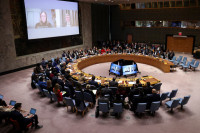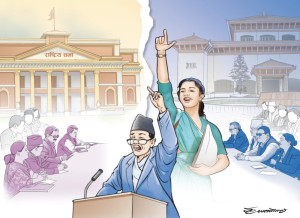Columns
Can Oli the autocrat become a democrat?
It requires a willingness to embrace collaboration and a respect for democratic principles.
Sambridh Ghimire
Three years ago, I pondered whether Nepal’s political landscape could shift towards genuine democratic governance, focusing on Prime Minister KP Sharma Oli, whose authoritarian tendencies have long been a concern. My modest hope was that no single party would secure a majority in the House of Representatives, compelling a coalition government. Given Oli’s history of centralising power, a coalition might force a more collaborative and democratic approach.
At the time, this outcome seemed remote. Oli’s Nepal Communist Party (NCP) enjoyed a comfortable majority, and the prime minister’s autocratic style was unchallenged. Yet, the political tide has shifted in recent months. The split within the NCP and the formation of a coalition government involving various parties, including the Nepali Congress, have created a new political reality. This raises a critical question: Can Oli, an autocrat by nature, transform into a democrat in this coalition government?
In his earlier tenure, Oli demonstrated a strong inclination to centralise authority, sidelining dissent within his party and showing little regard for collaborative governance. His approach mirrored that of Narendra Modi in India, relying on a personality cult and projecting himself as the sole architect of national progress. This modus operandi often led to tensions within the government and with opposition parties.
Centralisation of power
Oli’s autocratic nature is evident in both his handling of party affairs and his approach to governance. Oli has been known to marginalise his political rivals and consolidate power within the NCP. His leadership has often involved bypassing party structures and making unilateral decisions, undermining the collective decision-making process fundamental to any democratic organisation. This centralisation of power within the party has created significant rifts, leading to the eventual split of the NCP.
One of the most telling examples of Oli’s autocratic approach was his attempt to dissolve the parliament in December 2020, a move widely criticised as unconstitutional. This decision came amid growing dissent within his party and was perceived as an attempt to sideline his critics and extend his grip on power. The Supreme Court’s subsequent decision to reinstate the parliament was a significant blow to Oli, highlighting the limits of his authority and the resilience of Nepal’s democratic institutions.
A disregard for institutional checks and balances has marked Oli’s tenure in government. His administration has frequently clashed with the judiciary, the media and civil society. Oli’s government has been accused of stifling dissent and curbing press freedom. In several incidents, journalists and media outlets critical of the government faced harassment and legal challenges. This has created an environment of fear and self-censorship, eroding the democratic fabric of the nation.
Moreover, Oli’s handling of the Covid-19 pandemic had drawn criticism for its centralisation and lack of transparency. Decisions regarding lockdowns, vaccine procurement and public health measures were often made without adequate consultation with experts or coordination with provincial governments. This top-down approach led to inefficiencies and delays, exacerbating the public health crisis.
The present government is criticised for not being inclusive, with only two women and no Dalits among the 22-member Council of Ministers. For Oli as the Prime Minister, this underscores his inability or unwillingness to address these critical issues of representation and inclusivity. It reflects poorly on his leadership and raises serious questions about his dedication to genuine democratic values and the equitable governance of Nepal.
On the other hand, Oli’s government has appointed a woman, Lila Devi Badtaula, as Chief Secretary for the first time in Nepal, marking a significant milestone in gender representation. This ground-breaking appointment contrasts with the broader issues of underrepresentation and suggests a complex narrative in Oli's approach to governance. While this historic step is commendable, the lack of inclusivity remains a significant challenge for his administration.
Opportunity for transformation
The dynamics of a coalition government are fundamentally different. Unlike a single-party majority, a coalition requires negotiation, compromise and power-sharing. Oli now finds himself in a position where his usual autocratic strategies may not suffice. The Nepali Congress, a party with a long tradition of democratic principles, is unlikely to tolerate any attempt to centralise power.
In this context, it is instructive to look at historical precedents. Indian leaders like PV Narasimha Rao, Atal Bihari Vajpayee and Manmohan Singh, adopting a collaborative approach, successfully navigated coalition governments. They recognised the necessity of working with diverse political actors, respecting institutional checks and balances and fostering a culture of consultation. Balancing authority with democratic principles was key to their effective governance.
Oli, on the other hand, has no such track record. His political career has exposed many confrontations with political rivals, civil society and even international actors.
Yet, the coalition government with the Nepali Congress presents an opportunity for transformation. For Oli, the first step towards becoming a democrat would be to genuinely share power with his coalition partners. This means involving them in decision-making processes, respecting their viewpoints and working towards consensus on key issues. It also means refraining from undermining democratic institutions and processes for political gain.
Moreover, Oli must rebuild trust with the public and the political establishment. His confrontational style has alienated many stakeholders. Demonstrating a commitment to democratic norms, such as respecting the independence of the judiciary, ensuring media freedom and fostering political dialogue, could help restore confidence in his leadership.
In the short term, we might see symbolic gestures of moderation from Oli. These could include less aggressive rhetoric against political opponents and a greater willingness to engage in parliamentary debates. However, whether these gestures translate into substantive changes in governance remains to be seen. The instincts of a leader accustomed to unchallenged authority do not change overnight.
The coming months will be crucial in determining Oli’s legacy. Suppose he can adapt to the demands of coalition politics and embrace a more democratic style of governance. He might pave the way for Nepal’s more stable political future in that case. If not, the coalition may become unstable, and his tenure may see continual political strife.
While the coalition government with the Nepali Congress offers Oli a unique opportunity to shed his autocratic tendencies, the path to genuine democratic leadership is fraught with challenges. It requires a fundamental shift in approach, a willingness to embrace collaboration and a respect for democratic principles. Whether Oli can make this transition will be a defining test of his political career and a significant determinant of Nepal’s democratic trajectory.




 16.2°C Kathmandu
16.2°C Kathmandu















